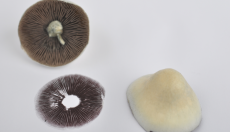How to make a spore print?
Posted under: How to's

Psilocybe cubensis is a species of mushroom that contains the psychoactive compound psilocybin. One way to propagate this species is by using spores. A spore print is simply a collection of spores that are harvested from the gills of a mature mushroom.
Mushroom spore prints are used to identify the species of a mushroom, and can also be used to cultivate new mushrooms. The spore print shows the color and pattern of the spores, which can vary widely between different species. By comparing the spore print to identification keys or guides, you can determine the species of the mushroom.
Once you have made a spore print, you can use it to start a mushroom culture by inoculating sterilized substrate, such as rye or wheat grains, with the spores. This can be done using a sterile technique and requires some basic equipment and knowledge of mushroom cultivation. The spores will germinate and form mycelium, which can then be transferred to other substrates to grow mature fruiting bodies.
Spore prints can also be used to preserve the genetic diversity of a mushroom species. By collecting and storing spore prints from different mushrooms, you can create a spore bank that can be used for research, breeding, or conservation purposes.
If you do not intend to use the spore print immediately, you can store it in a cool, dry, and dark place such as a refrigerator. Make sure the spore print is completely dry before storing it, as moisture can cause contamination and reduce the viability of the spores. You can store the spore print in a small ziplock bag, sealed and labeled with the type of mushroom and the date of collection. When you are ready to use the spores, you can simply remove them from the foil or paper and use them to inoculate your substrate.
How to make a spore print from a Psilocybe cubensis mushroom:
- Choose a mature mushroom: Select a mature mushroom with open caps and dark gills.
- Cut off the stem: Use a sterilized knife or scissors to cut off the stem of the mushroom. You only need the cap for the spore print.
- Place the cap gill-side down: Place the cap of the mushroom on a piece of paper, foil or glass, gill-side down. Use black or white paper for better visibility of the spores.
- Cover with a bowl: Place a bowl or jar over the mushroom cap to create a microclimate that will help the spores release.
- Wait 12-24 hours: Leave the mushroom covered for 12-24 hours. During this time, the spores will fall from the gills and collect on the paper or glass beneath.
- Remove the cap: After 12-24 hours, remove the cap of the mushroom to reveal the spore print. The spores will look like a fine powder on the paper or glass.
- Store the spore print: Once you have your spore print, allow it to fully dry before storing it in a cool, dry place. You can store the spore print in a sealed plastic bag or glass jar. Spore prints can be stored for years if kept in the right conditions.
The best surface to use for spore printing is sterile aluminum foil. Cut a piece of aluminum foil and sterilize it with a flame or by rubbing alcohol on it. Place the mushroom cap on the foil with the gills facing down. Cover the cap with a clean glass or jar to create a humid environment. After 24 hours, remove the glass or jar and carefully lift the cap away from the foil. You should see a spore print on the foil where the gills made contact.
To store the spore print, let it dry completely and then fold the foil to enclose the print. Place the foil packet in a small ziplock bag, seal it and label it with the type of mushroom and the date of collection. Store the spore prints in a cool, dark, and dry place such as a refrigerator until ready to use.
It's worth noting that some species of mushrooms produce white or light-colored spores that may not be visible on aluminum foil. In this case, you can try using a darker surface like black construction paper or a piece of glass. It's also important to handle spores carefully to avoid contamination, as they can be sensitive to environmental factors like moisture and bacteria. With proper handling and storage, a single spore print can produce many generations of mushrooms.
Now that you have your spore print, you can use it to propagate Psilocybe cubensis mushrooms. However, it's important to note that cultivating psilocybin-containing mushrooms may be illegal in your country or state. Check local laws before attempting to grow or propagate these mushrooms.
If you do decide to propagate Psilocybe cubensis mushrooms, you can use the spores to create spore syringes or inoculate a substrate. Spore syringes can be used to inoculate jars filled with sterilized substrate. The jars are then placed in a warm, dark environment until the mycelium has colonized the entire substrate. The substrate can then be used to fruit mushrooms.
Making a spore print from a Psilocybe cubensis mushroom is a simple process that can be used to propagate this species. Spore prints can be stored for years and used to create spore syringes or inoculate substrates.


January 26, 2012